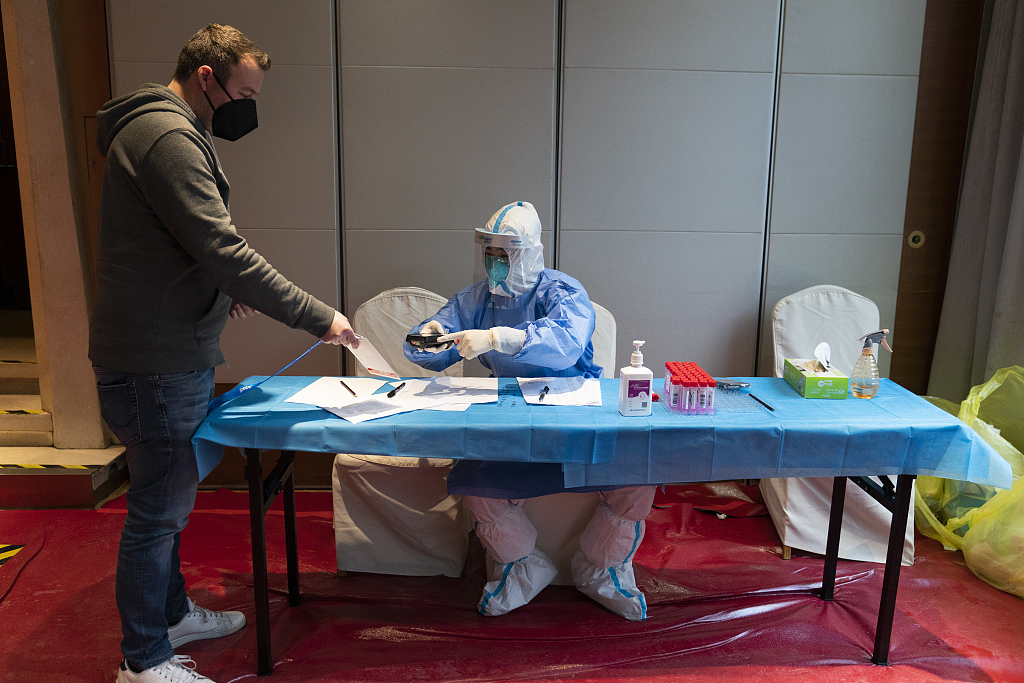
A general view of the National Speed Skating Oval ahead of the Beijing 2022 Winter Olympic Games in Beijing, China, February 1, 2022. /CFP
A general view of the National Speed Skating Oval ahead of the Beijing 2022 Winter Olympic Games in Beijing, China, February 1, 2022. /CFP
Editor's note: Mi Wenzhong is a professor in the Department of Engineering Physics at Tsinghua University and the project leader of the National Key Research and Development Program "Risk Analysis and Prevention and Control Technologies for the Epidemic Affecting the Beijing Winter Olympic Games." The article reflects the author's opinions and not necessarily the views of CGTN.
With only three days to go until the 2022 Beijing Winter Olympic Games, the eyes of the world are on this pageantry. Against the backdrop of the global COVID-19 pandemic, the holding of a major sports event is undoubtedly under enormous pressure. Proper epidemic prevention and control is key to the safe running of the Beijing Winter Olympic Games. We have conducted research in key areas such as prevention, control and analysis of epidemic risks, epidemic prevention at ports of entry and disinfection of key venues. We have developed a series of strategies and new technologies for Beijing 2022, which will be applied in the whole process of epidemic prevention and control before, during and after the Games, hence providing strong support for the science-based prevention and control of COVID-19 in this event.
Firstly, we've developed epidemic monitoring and early warning technology based on big data to provide a scientific basis for epidemic prevention and control decisions.
Based on the latest infection data in the world, we continuously track the trend of the global pandemic, virus mutation, vaccination progress, testing results of inbound travelers and goods, etc. We've carried out a rapid assessment of the risk of potential virus infiltration, providing a factual basis for formulating epidemic prevention and control measures at customs ports. We've put together multiple data sources to optimize the epidemic monitoring strategy for the Winter Olympics. By building a mathematical model of COVID-19 testing strategies, we've compared the risks and benefits of different testing strategies during an outbreak. Our research shows that when the positive rate is 1.5 to 2 percent, athletes need to undergo a daily routine test during the Games, and teams with infected individuals need an additional test per person. This strategy has been officially included in the epidemic prevention and control program for the Games.
Secondly, we've built a risk assessment system for virus transmission during the Beijing Winter Olympic Games based on digital twin technology to scientifically identify risk points for prevention and control.
Using digital twin technology powered with fine-grained data, we have developed a virus transmission risk assessment system for Beijing 2022 based on a 1:1 simulation of the actual scenario in the venues. It can simulate the games based on the competition schedule, simulate and track individual behavior, and monitor the occurrence of infection events in real-time. Based on the simulation, we can accurately identify high-risk populations, susceptible areas and behaviors, and weak links in the prevention and control system, thereby providing response strategies for emergencies in the Olympic venues. Our simulation results show that the current control measures are effective in preventing and responding to cross-infection among different groups of people. On top of that, we have developed an origin tracing technology that can efficiently and accurately identify the source of virus transmission for reference among the Organizing Committee and the epidemic prevention and control task force.

A medical worker in protective gear scans an Olympic credential of a video technician visiting from Belgium at a COVID-19 testing site set up inside a hotel for the 2022 Winter Olympics in Beijing, January 25, 2022. /CFP
A medical worker in protective gear scans an Olympic credential of a video technician visiting from Belgium at a COVID-19 testing site set up inside a hotel for the 2022 Winter Olympics in Beijing, January 25, 2022. /CFP
Thirdly, technical documents on epidemic prevention and control have been formulated based on the research to guide the Organizing Committee on specific measures.
We have worked closely with the Organizing Committee to jointly tackle key problems and submitted more than 10 research reports related to epidemic prevention and control, providing important technical support for the development of many epidemic prevention and control programs, such as remote control and prevention for inbound personnel, closed-loop management of inbound personnel, and post-Games personnel management. We've formulated the Beijing 2022 Playbook for Athletes and Team Officials, the Beijing 2022 Winter Olympic and Paralympic Games Emergency Response Plan for Public Health Emergencies, as well as the epidemic prevention and control mechanism, personnel management mechanism, policies on health and symptom monitoring, coronavirus monitoring, disinfection and many other programs. They've been submitted to the Organizing Committee and officially issued to guide the epidemic prevention and control and emergency response work during the Winter Olympic Games.
Fourthly, we've built an epidemic risk analysis and emergency decision-making system to strengthen the command and control capabilities during the Games.
We've developed a decision-making system that features key modules such as public health, health inspection, global pandemic update and medical assistance. The system is powered by integrated decision-making technologies and looks at all possible scenarios during Beijing 2022. It enables risk assessment, resource allocation, medical assistance and visualized analytics and supports the automatic daily updating of public health inspection data covering 120 venues and hotels within the closed-loop of the Winter Olympic Games, providing visualized analysis of the health profile at each venue and in general during the Games. The system can comprehensively, intuitively, accurately and efficiently reflect the general epidemic prevention and control status, strengthening the command and control capabilities in preventing and controlling the epidemic during the whole Beijing 2022. The system has been launched at the main operation center of the Organizing Committee of the Beijing Winter Olympic Games and will be used to ensure the smooth running of the entire Games.
Considering the profound impact of the global pandemic, we hope to strike the right balance between having an exciting sports event and implementing strict management and control rules. We aim to bring a better experience to those involved in the Olympic Games through rational planning and the application of new technologies. With the help of technology, we are confident that China will deliver a "simple, safe and wonderful" Winter Olympic Games to the world.
(If you want to contribute and have specific expertise, please contact us at opinions@cgtn.com.)

